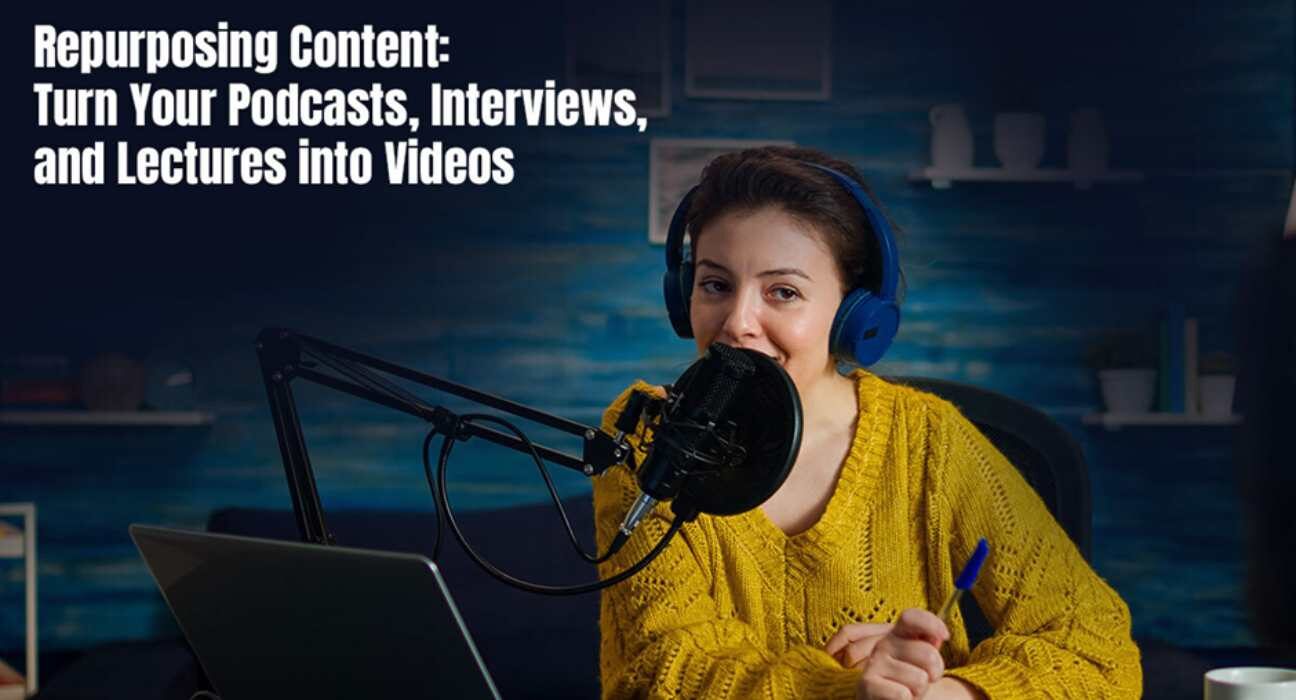We are living in a content-driven, digital world. One of the biggest challenges faced by content creators today is creating fresh material to keep the audience engaged. But what if we told you that you can breathe new life into existing content you have already produced?
Yes, you heard that right. You can repurpose your interviews, podcasts, and lectures into engaging videos. This offers a time-efficient and strategic way to maximize the impact and reach of your content.
Are you intrigued? Do you have podcasts, lectures, or interviews that you have been wanting to repurpose? This guide is what you need. Continue scrolling.
Why Repurpose Audio Content?
Creating high-quality lectures, interviews, or podcasts requires significant effort and time. By repurposing this content into video format, you will be enjoying the following benefits:
- Expands reach – Videos are a powerful engagement tool. So, transforming your audio content into video means tapping into a wider audience who prefer consuming video content. YouTube and similar platforms offer immense potential to attract new viewers who may not have found your lecture or podcast otherwise.
- Enhances engagement – Visual elements significantly improve audience engagement. Adding visuals like relevant images, speaker headshots, or animations can keep the audience hooked and retain their attention for longer.
- Maximizes content ROI – You have already invested a lot of resources, time and effort in creating the core content. Hence, repurposing the audio content to a video means extracting additional value from your existing work.
Converting Audio To Video: A Step-By-Step Guide
The transformation of your audio content into engaging videos involves a few simple steps:
- Selecting the content
The first step is to choose the audio content that you wish to convert to a video. It could be one of your old interviews with interesting anecdotes or lectures with clear instructions.
- Developing the script
While you already have the audio track, it is recommended to create a basic script outlining the key points and speaker transitions. It would also help to develop a storyboard so the process can be further enhanced.
- Choosing the right software
There’s a variety of converters available that allow you to easily convert audio to video with pictures. For instance, if you are a Mac user wondering how to convert audio file to video, you can do so using Permute. Permute is a highly convenient converter that quickly changes audio files to video. All you have to do is choose the file you wish to convert, add it to Permute, and then choose MP4 as the end file format. Similarly, you will find other converters for the operating system you are comfortable with.
- Selecting a video editor
You can choose a free video editor to add polished touches to the final video. The editor will help you add visual elements and make other changes to the video. Some popular video editing programs are Invideo.io, Adobe Premiere Pro and iMovie.
If required, you can add background music and titles to ensure your video is engaging for your audience.
Additional Tips To Ensure The Repurposed Video Content Appeals To Your Audience
- Remember to keep it concise – Attention spans are shorter online. So, edit your video to a length suitable for your preferred platform. The focus must be on the most impactful portions of your audio content.
- Promote your videos – Uploading and hoping for the best won’t take you far. It is essential to promote your repurposed videos across websites, social media channels, and your email list. You can also consider paid advertising options.
- Optimize for mobile viewing – Most people consume content on their mobile phones. Therefore, ensure the video has proper aspect ratios and captions.
Beyond Video: Additional Ways To Repurpose Existing Audio Content
Repurposing your audio content does not stop at video. Here are additional ways to extract maximum value from your existing content:
- Develop social media snippets – Extract engaging, short audio clips from your lectures, interviews, or podcasts and share them on social media platforms. These bite-sized pieces will pique the interest of your viewers.
- Create blog posts – The key points from your audio content can be summarized into a blog post.
- Infographics – Visually represent important concepts or data discussed in your audio content by designing infographics. Share them across your social media channels.
- Offer transcripts – Create written transcripts of your audio content and share them with your viewers. This is perfect if your audience prefers reading.
The Bottom Line
So, adopt these strategies to repurpose your existing audio content to video and beyond. This will transform your audio content and breathe new life into them. It will maximize your ROI as you don’t have to invest more effort and time to create new content. Also, keeping this in mind is great for times when you are experiencing a creative blog and unable to come up with new content. By repurposing content, you will keep your audience hooked.

